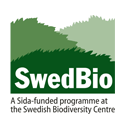Click on images to enlarge
/thumbs/argemone_mexicana9_-_FKS_sml.jpg)
close-up of flower showing shallowly-lobed red stigma (Photo: Forest and Kim Starr, USGS)
/thumbs/argemone_mexicana6_sml.jpg)
close-up of immature fruit with whitish markings and numerous spines (Photo: Sheldon Navie)
/thumbs/argemone_mexicana4_sml.jpg)
upper leaves and spine-tipped flower buds (Photo: Sheldon Navie)
/thumbs/argemone_mexicana1_-_SH_sml.jpg)
close-up of seeds (Photo: Steve Hurst at USDA PLANTS Database)
Scientific name
Argemone mexicanaL.
Synonyms
Argemone leiocarpaGreene
Common names
Mexican poppy, Mexican prickly poppy, Medicinal weed, satyanashi, prickly poppy, ekijembajembe (Ankole), mkumajalaga (Yao)
Family
Papaveraceae
Origin
The exact native range of this species is obscure, but it is often thought to be native to south-eastern USA (Florida), Mexico, Central America, the Caribbean and tropical South America. Others believe it to be introduced to South America and Florida.
Naturalised distribution (global)
Argemone mexicana is naturalised throughout the tropics and sub-tropics as an agricultural weed.
Introduced, naturalised or invasive in East Africa
Argemone mexicana is invasive in parts of Kenya and Uganda (A.B.R. Witt pers. obs.) and Tanzania (Macdonald et al. 2003). It is widespread throughout the region, especially on fallow land.
Habitat
Argemone mexicana tends to grow along roadsides, in fallow and cultivated lands, riverbanks, disturbed areas, and on floodplains. It competes with and replaces native species in some cases and is also a significant crop weed.
Description
Argemone mexicana is an annual herb, growing up to 150 cm with a slightly branched tap root. Its stem is branched and usually extremely prickly. It exudes a yellow juice when cut. It has showy yellow flowers.
Leaves are thistle-like and alternate, without leaf stalks (petioles), toothed (serrate) and the margins are spiny. The grey-white veins stand out against the bluish-green upper leaf surface. The stem is oblong in cross-section.
Flowers are at the tips of the branches (are terminal) and solitary, yellow and of 2.5-5 cm diameter. Fruit is a prickly oblong or egg-shaped (ovoid) capsule. Seeds are very numerous, nearly spherical, covered in a fine network of veins, brownish black and about 1 mm in diameter.
Reproduction and dispersal
This species reproduces by seed. Most seeds fall around the parent plant but some are dispersed by water, mud adhering to boots and farming machinery and livestock. The seeds can also be dispersed by birds.
Similar species
Argemone Mexicana, A. ochroleuca, and A. subfusiformis are often confused.
From the CABI Crop Compendium: 'Argemone ochroleuca (A. mexicana forma ochroleuca) has creamy white to yellow petals, an ellipsoid capsule narrowed at both ends, seeds approximately 1.5 mm in diameter. Ownbey (1997) differentiates it from A. mexicana on the basis of differences in flower bud shape and petal colour. Chaturvedi et al. (1999) have suggested that it can naturally hybridize with A. mexicana. In Zimbabwe, these two species are viewed as colour forms of one species A. mexicana (Hyde and Wursten, 2002).
A. subfusiformis is closely related to A. ochroleuca. It has cream to pale yellow petals, capsule slenderly spindle-shaped and seed approximately 2 mm in diameter. A subspecies, A. subfusiformis ssp. subfusiformis, with deep yellow flowers.'
Economic and other uses
Argemone mexicana is an ornamental plant and is sometimes used as a soil enricher for crops - after slashing. Plant extracts can be used as an insecticide and medicinal properties have been attributed to the sap and oil from the seed. However, these uses cannot compensate for this plant's overall negative impacts.
Environmental and other impacts
Argemone mexicana is a serious agricultural weed. Where over-grazing reduces grass cover this can favour unpalatable species including A. mexicana. This plants is toxic to animals and cattle avoid grazing it. Harmful allelopathic effects of A. mexicana are recorded on germination and seedling vigour of wheat, mustard, fenugreek, sorghum, fingermillet, tomato, cucumber etc. (Moore 1990). The allelochemicals cinnamic and benzoic acid are identified as harmful chemicals responsible for inhibition of germination and seedling vigour. Edible vegetable oil either accidentally or deliberately contaminated with A. mexicana has resulted in epidemic dropsy in India. An epidemic occurred in South Africa following the contamination of wheat flour with A. mexicana. Harvesting crops in field infested with A. mexicana can be painful as the plant is poisonous and a skin irritant.
Argemone mexicana has been listed as noxious weed in South Africa (prohibited plants that must be controlled. They serve no economic purpose and possess characteristics that are harmful to humans, animals or the environment) and in states in Australia (New South Wales and Western Australia).
Management
The precise management measures adopted for any plant invasion will depend upon factors such as the terrain, the cost and availability of labour, the severity of the infestation and the presence of other invasive species. Some components of an integrated management approach are introduced below.
The best form of invasive species management is prevention. As Argemone mexicana is so widespread this is unlikely to be possible in many instances.
If prevention is no longer possible, it is best to treat the weed infestations when they are small to prevent them from establishing (early detection and rapid response). Controlling the weed before it seeds will reduce future problems. Control is generally best applied to the least infested areas before dense infestations are tackled. Consistent follow-up work is required for sustainable management.
Regular and timely weeding will encourage dominance of desirable species. Hand weeding of A. mexicana is possible but it can be painful. Weeding should be carried out before the plant has set seed. Light tillage can destroy seedlings. Spraying with a suitable herbicide can control A. mexicana. When using any herbicide always read the label first and follow all instructions and safety requirements. If in doubt consult an expert.
Management of grazing levels is likely to reduce susceptibility to A. mexicana infestations.
A biological control programme for A. mexicana and the closely related Argemone ochroleuca has been initiated in Australia (Prota database).
Legislation
Not listed as a noxious weed by the state or governments in Kenya, Tanzania and Uganda.
References
CABI Crop Compendium online data sheet. Argemone mexicana (Mexican poppy). CABI Publishing 2011. www.cabi.org/CPC. Accessed March 2011.
Henderson, L. (2001). Alien weeds and invasive plants. A complete guide to declared weeds and invaders in South Africa. Plant Protection Research Institute Handbook No. 12, 300pp. PPR, ARC South Africa.
Macdonald, A.W., Reaser, J.K., Bright, C., Neville, L.E., Howard, G.W., Murphy, S.J., Preston, G. (eds) (2003). Invasive Alien Species in South Africa: National Reports and Directory of Resources. GISP, Cape Town, SA.
Moore, M. (1990). Los Remedios: Traditional Herbal Remedies of the Southwest. Museum of New Mexico Press, Santa Fe, New Mexico.
PROTA database. Prota 11(1): Medicinal plants/Plantes médicinales 1. Record display: Argemone mexicana L. database.prota.org/PROTAhtml/Argemone%20mexicana_En.htm. Accessed January 2011.
Singh, S., Singh, T.D., Singh, V.P. and Pandey, V.B. (2010). Quaternary alkaloids of Argemone mexicana. Pharmaceutical Biology. 48(2):158-60.
Editors
Agnes Lusweti, National Museums of Kenya; Emily Wabuyele, National Museums of Kenya, Paul Ssegawa, Makerere University; John Mauremootoo, BioNET-INTERNATIONAL Secretariat - UK.
Acknowledgments
This fact sheet is adapted from The Environmental Weeds of Australia by Sheldon Navie and Steve Adkins, Centre for Biological Information Technology, University of Queensland. We recognise the support from the National Museums of Kenya, Tropical Pesticides Research Institute (TPRI) - Tanzania and Makerere University, Uganda. This activity was undertaken as part of the BioNET-EAFRINET UVIMA Project (Taxonomy for Development in East Africa).
Contact
BioNET-EAFRINET Regional Coordinator: [email protected]












